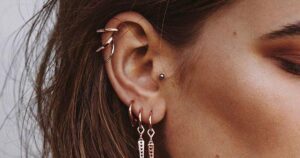Earrings are not just accessories; they hold the power to enhance our appearance and express our style. However, for some, adorning earrings can be a perplexing experience as they notice their earlobes turning black or experiencing other discomforts. In this comprehensive guide, we’ll delve into the various factors causing this issue and explore ways to alleviate it. Whether you’re a seasoned earring enthusiast or new to the world of ear piercings, understanding why your ears react in this manner can help you enjoy wearing earrings without worry.
Understanding Silver Tarnish
Silver earrings are a popular choice for their elegance and versatility. However, one common issue faced by wearers is the tarnishing of silver, leading to discoloration of the skin around the earlobe. This phenomenon occurs due to a chemical reaction between the silver and compounds present in the environment, such as sulfur and oxygen. When silver comes into contact with these substances, it forms silver sulfide, a dark compound responsible for the blackening of the metal and the skin.
To prevent silver tarnish from causing your ears to turn black, consider opting for sterling silver earrings, which contain a higher percentage of pure silver mixed with other metals like copper. Additionally, storing your silver earrings in airtight containers or using anti-tarnish strips can help preserve their luster and minimize the risk of discoloration.
Can You Fix Uneven Ear Piercings?

Uneven ear piercings can be a source of frustration and self-consciousness for many individuals. Whether the discrepancy is subtle or noticeable, it can affect the overall symmetry and aesthetic appeal of your earlobe. Fortunately, there are several options available to address this issue and achieve a more balanced look.
One solution is to seek the assistance of a professional piercer who can assess the placement of your existing piercings and recommend adjustments as needed. In some cases, minor modifications can be made to the positioning of the earrings or the creation of new piercings to achieve symmetry. Alternatively, specialized earrings designed for stretching or reshaping the earlobe may also help correct mild asymmetry over time.
Crusting After Piercing
After getting a new piercing, it’s not uncommon to experience crusting around the area as part of the healing process. This crust, often referred to as “piercing crusties,” is a combination of dried blood plasma, lymphatic fluid, and dead skin cells that accumulate around the piercing site. While it may seem unsightly, crusting is a natural response of the body’s immune system as it works to repair the damaged tissue and prevent infection.
To minimize crusting and promote healing, it’s essential to maintain proper hygiene practices. Gently clean the pierced area twice a day with a saline solution or mild soap and water to remove any buildup of crust and debris. Avoid picking or scratching at the crust, as this can cause further irritation and delay the healing process. With patience and diligent care, the crust will gradually diminish, and your piercing will heal beautifully.
The Mystery of “Ear Cheese”

“Earring cheese,” also known as cerumen, is a waxy substance that can accumulate on earrings and around the piercing site over time. This buildup is a combination of sebum, dead skin cells, and sweat, which provides a breeding ground for bacteria and fungi. As a result, wearers may notice a foul odor emanating from their earrings or experience itching and irritation.
Preventing the formation of ear cheese requires regular cleaning and maintenance of both your earrings and earlobes. Remove your earrings daily and gently wipe them with a clean cloth or cotton swab dipped in rubbing alcohol to disinfect and remove any buildup. Likewise, cleanse your earlobes with soap and water, taking care to dry them thoroughly to prevent moisture accumulation. Avoid wearing earrings made of materials that can exacerbate the problem, such as nickel or cheap alloys, and opt for hypoallergenic options instead.
Are Earring Holes Permanent?
Many people wonder whether the holes created for ear piercings are permanent or if they can close up over time. The answer largely depends on the individual and various factors such as the size and location of the piercing, as well as how long it has been since the last time earrings were worn.
In general, earlobe piercings tend to be more likely to close up if left without earrings for an extended period, particularly if they were performed using a standard piercing needle. However, cartilage piercings, such as those in the upper ear or tragus, are more likely to remain open due to the denser nature of cartilage tissue. To prevent earring holes from closing, it’s advisable to wear earrings regularly, even if only small studs, to maintain the integrity of the piercing.
Styling Multiple Ear Piercings

Multiple ear piercings have become a popular trend, allowing individuals to express their creativity and personal style through curated ear stacks and combinations. Whether you’re a fan of minimalist designs or prefer a more eclectic look, there are countless ways to mix and match earrings to create a unique aesthetic.
When styling multiple ear piercings, consider factors such as earring size, shape, and placement to achieve a harmonious balance. Start by selecting a focal point, such as a statement stud or hoop, and build around it with complementary pieces that vary in size and texture. Experiment with asymmetrical arrangements or symmetrical clusters to find a configuration that reflects your individuality and enhances the natural contours of your ear.
Dealing with Infected Ear Piercings
An infected ear piercing can quickly turn what should be an exciting experience into a painful ordeal. Symptoms of infection may include redness, swelling, warmth to the touch, and discharge of pus or blood from the piercing site. If left untreated, an infection can lead to complications such as abscess formation or the spread of bacteria to surrounding tissues.
If you suspect that your ear piercing is infected, it’s crucial to seek prompt medical attention to prevent further complications. Your healthcare provider may prescribe antibiotics or recommend topical treatments to help clear the infection and promote healing. In the meantime, avoid removing the earring, as this can trap bacteria inside the piercing and worsen the infection. Instead, gently clean the area with saline solution or antiseptic solution as directed and avoid touching or manipulating the piercing unnecessarily.
Cleaning and Maintenance Tips

Proper cleaning and maintenance are essential for preserving the beauty and longevity of your earrings and ensuring the health of your earlobes. Here are some tips to keep your earrings sparkling and your ears happy:
- Clean your earrings regularly with a soft cloth or cotton swab dipped in rubbing alcohol to remove dirt, oil, and bacteria.
- Avoid exposing your earrings to harsh chemicals or abrasive substances that can damage the metal or gemstones.
- Store your earrings in a dry, cool place away from direct sunlight and humidity to prevent tarnishing and discoloration.
- Rotate your earrings frequently to prevent pressure sores and allow air circulation around the piercing site.
- If you experience any discomfort or irritation while wearing earrings, remove them immediately and consult a healthcare professional if necessary.
FAQs
Why is my earlobe turning black?
Affected individuals develop a condition called ochronosis, in which connective tissue such as cartilage turns blue, grey or black due to the chronic accumulation of homogentisic acid. In many individuals, cartilage within the ear may become thickened, irregular and discolored blue, grey or black.
What is the black gunk in earring holes?
These discharges mixed with dirt from lack of cleaning can also oxidize, leaving a black or grey gunk. This gunk can be pushed out with a clean earring or washed out with warm soap and water. You can enter a clean earring into the hole from the front or back to try and budge the gunk.
What kind of earrings won’t turn black?
“Truly fade-proof jewelry metals are solid metals such as solid gold, titanium, platinum, non-plated stainless steel and non-plated sterling silver,” explains Deng.
Conclusion
In conclusion, the phenomenon of ears turning black with earrings can be attributed to various factors such as silver tarnish, infection, or buildup of debris. By understanding the underlying causes and implementing proper care and maintenance practices, you can enjoy wearing earrings without fear of discomfort or discoloration. Remember to listen to your body and seek professional advice if you encounter any issues with your ear piercings. With patience and diligence, you can adorn your ears with confidence and style, showcasing your unique personality for all to admire.













